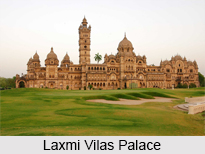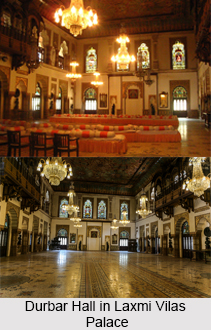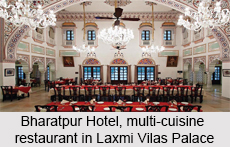 Laxmi Vilas Palace is a historical palace, a part of the group of palaces in Vadodara, Gujarat, collectively termed as the Maharaja Palace. The Laxmi Vilas is the second prominent monumental palace in the series of palaces, an extravagant structure constructed in the Indo-Saracenic architectural style by Maharaja Sayajirao Gaekwad III, in 1890 at a cost of 180,000 Great Britain Pounds.
Laxmi Vilas Palace is a historical palace, a part of the group of palaces in Vadodara, Gujarat, collectively termed as the Maharaja Palace. The Laxmi Vilas is the second prominent monumental palace in the series of palaces, an extravagant structure constructed in the Indo-Saracenic architectural style by Maharaja Sayajirao Gaekwad III, in 1890 at a cost of 180,000 Great Britain Pounds.
Architectural Features of Laxmi Vilas Palace
The Laxmi Vilas Palace is reputed to have been the largest private dwelling erected to date, four times the size of Buckingham Palace. At the time of construction, it boasted of most modern amenities such as elevators and the interiors that are reminiscent of a large European country house. It remains the residence of the royal family, who continue to be held in high esteem by the residents of Vadodara.
It has a resplendently ornate Durbar Hall, with Italian mosaic floor and walls. It is sometimes the venue of musical concerts and other cultural events. The Belgium stained glass windows and walls are embellished with intricate mosaic decorations. Outside the Durbar Hall is an Italianate courtyard of water fountains.
 The palace boasts a rich collection of antiques such as old armoury and sculptures in bronze, marble and terracotta. The palace has two important buildings in its compound that stretches over an area of 700 acres (2.8 square kilometres), namely the Moti Baug Palace and the Maharaja Fateh Singh Museum. The grounds were landscaped by William Goldring, a specialist from Kew Gardens. The palace is open to the public and an audio tour is available.
The palace boasts a rich collection of antiques such as old armoury and sculptures in bronze, marble and terracotta. The palace has two important buildings in its compound that stretches over an area of 700 acres (2.8 square kilometres), namely the Moti Baug Palace and the Maharaja Fateh Singh Museum. The grounds were landscaped by William Goldring, a specialist from Kew Gardens. The palace is open to the public and an audio tour is available.
Packs of langoors and peacocks are spotted around the palace compound. The Museum building was constructed as a school for the Maharaja`s children. Today a large number of works of art belonging to the royal family have been put on display in the museum, the most remarkable of which is the collection of paintings of Raja Ravi Varma, who was specially commissioned by the then Maharaja of Baroda. The collection includes portraits of the royal family, in addition to the paintings based on Hindu mythology for which Raja Ravi Varma was acclaimed.
The Maharaja constructed a miniature railway line, which circled the mango orchard within the palace compound, to take his children from the school to the main palace building. The train engine was recently refurbished by Ranjitsinh Pratapsinh Gaekwad, who was the Maharaja during the time, and can be seen at the entrance to the Museum.
The palace also boasted a small zoo, the only remnant of which is the pond where a number of crocodiles remain. The Navlakhi Well, literally meaning "of nine hundred thousand", is a fine `baoli` or step well, 50 metres north of the palace.
Other Noticeable Aspects of Laxmi Vilas Palace
The compound of Laxmi Vilas Palace is also suitable for holding a variety of sporting activities. Adjacent to the Moti Baug Palace and the Museum is the Moti Bagh Cricket Ground, the offices of the Baroda Cricket Association and a very rare indoor teak-floored tennis court and badminton court, where the All India Badminton Championships were previously held. There are also two clay tennis courts along with a derelict fives court.
In the 1930s, Maharaja Pratap Singh Gaekwad created a golf course for use by his European guests. In the 1990s, Pratap Singh`s grandson Samarjitsinh, a former Ranji trophy cricket player, renovated the course and opened it to public. The course was expanded in 2004 into an elegant golf course managed by the Gaekwad Baroda Golf Club, today boasting over 300 members. The Moti Baug Palace is today the club house for the club, behind which are a large swimming pool designed by the renowned architect Karan Grover, sauna and gym facilities.
 Bollywood movies "Prem Rog", "Grand Masti", "Rang Rasiya" and "Prem Ratan Dhan Payo" have been filmed at the picturesque grounds of the Laxmi Vilas Palace.
Bollywood movies "Prem Rog", "Grand Masti", "Rang Rasiya" and "Prem Ratan Dhan Payo" have been filmed at the picturesque grounds of the Laxmi Vilas Palace.
Related Articles:
Indian Historical Palaces
Vadodara, Gujarat
Gujarat
Indo-Saracenic Architecture in India
Monuments of Gujarat
Palaces of Gujarat
Maharaja Fateh Singh Museum, Vadodara
Raja Ravi Varma, Indian Painter
Maharaja Pratap Singh Gaekwad
Baroda Cricket Association
Gaekwads of Baroda



















